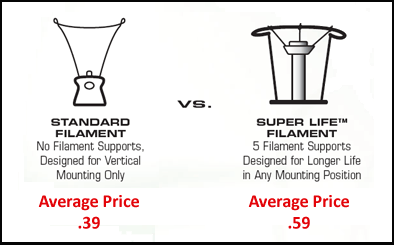Why Light Bulbs Don’t Last | Sarasota, FL
Synergy Lighting for years now has attempted to educate its customers on the value of quality light bulbs. In hard economic times, businesses often look for ways to cut expenses and save money. We see these businesses often perform layoffs or reduce their inventories in order to keep a positive cash flow. However most businesses do not realize their savings potential just by switching to quality light bulbs which can result in huge savings.
First we must identify the difference between price and cost. A .39 cent light bulb does not have a cost of .39 cents. That is the price of the bulb. The cost is measured by how much electricity is paid for to illuminate the bulb, and how much labor is paid to change the bulb time and again. For most businesses, a .39 cent light bulb has an annual cost of $42.65 when you calculate electricity and an employee changing the bulb twice a year at a pay rate of $10.00 per hour. Remember, a $10.00 an hour employ also has taxes to the business owner above and beyond their normal pay rate.
Three Things That Kill Light Bulbs:
Heat
Any illuminated light bulb has heat. Even cooler burning lamps such as CFL’s and Fluorescent produce some form of heating. This heat or burning of the filament or cathode, over time dissipates the tungsten and the filament becomes thinner and weaker till it eventual breaks.
Vibration
Often customers grin when we tell them about vibrations damaging the tungsten filaments or cathodes. The standard feedback is that their light bulbs are firmly mounted and do not have vibration. Air Conditioning, doors opening and closing and wind load forces on a building cause subtle vibrations undetectable to humans, but can be passed on to the filament of a lamp even if so subtle we can not feel them. As you will see in the video below, the filaments or cathodes have their own vibrations from molecule collisions while under a heat load.
Power Surge
Every time we turn a light on there is a power surge to the filament or cathodes. Many other power surges happen daily that we do not recognize, such as every time an Air Conditioner turns on or off, a large motor operates, or even a power surge from a laser printer spooling up. By design, the utility company redirects power to grids several times a day which causes a series of small power surges that are only sensitive to light bulb filaments.
It is only when we combine all three of these actions together that it kills a light bulb. Over time naturally the repetitiveness of these actions will kill the lamp, or if any one of the three has a drastic increase over the other we will realize this with a premature failure of the lamp.
 Sylvania, Philips, GE and many other manufacturers use a Standard Tungsten-Alloy Filament stretched between two filament supports. Unlike the Pure Tungsten Filaments invented by Thomas Edison, and used in most Industrial Grade Bulbs, the tungsten-alloy filament is weaker and does not hold up as long. This may be part of planned obsolescence, or a way to get a consumer to buy more bulbs. Industrial Grade lamps such as Halco, Superior Life Lamps use Pure Tungsten filaments with additional filament supports. This increase lamp life and stability when subjected to Heat, Vibration and Power Surge.
Sylvania, Philips, GE and many other manufacturers use a Standard Tungsten-Alloy Filament stretched between two filament supports. Unlike the Pure Tungsten Filaments invented by Thomas Edison, and used in most Industrial Grade Bulbs, the tungsten-alloy filament is weaker and does not hold up as long. This may be part of planned obsolescence, or a way to get a consumer to buy more bulbs. Industrial Grade lamps such as Halco, Superior Life Lamps use Pure Tungsten filaments with additional filament supports. This increase lamp life and stability when subjected to Heat, Vibration and Power Surge.
As previously stated above, the typical Philips, Sylvania, GE bulb with a price of .39 cents has a cost annually of $42.65. If we change to an Industrial Lamp with a price of .59 cents, the price is higher, but the resulting cost would be lowered to $33.92 per year because of it’s life that is 4 times longer. This has an additional Price of .20 cents that results in a cost savings of $17.46.
50 Bulbs saving $17.46 over 24 months would save a business approximately $873.00! That’s cutting costs!
Conclusion: Spending a few cents extra on a quality light bulb can result in tremendous savings and increased cash flow over time.
For more information on quality light bulbs, view our website or call Synergy Lighting for a free consultation.
Phone: (941)-756-4844
Toll Free: (877) 220-5483
e-mail: sales@synergylightingusa.com
![]()


Currently there are no comments related to this article. You have a special honor to be the first commenter. Thanks!
You must be logged in to post the comment!